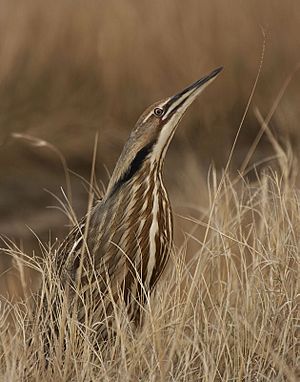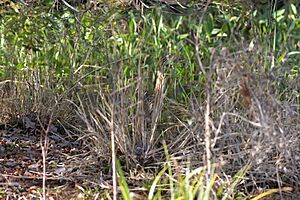American bittern facts for kids
Quick facts for kids American bittern |
|
|---|---|
 |
|
| Conservation status | |
| Scientific classification | |
| Genus: |
Botaurus
|
| Species: |
lentiginosus
|
 |
|
| Range of B. lentiginosus Breeding range Year-round range Wintering range | |
| Synonyms | |
|
|
The American bittern (Botaurus lentiginosus) is a special kind of wading bird. It belongs to the heron family. This bird lives in North America, from Canada down to Central America. It nests in the northern parts and flies south for winter. You can find it in places like Florida or the Caribbean islands.
This bird is brown and blends in very well with its surroundings. It likes to live alone in marshes, near lakes, and ponds. It hides among tall plants. During spring, you might hear the male's loud, booming call. It sounds a bit like a pump.
The female builds a nest just above the water. She often uses tall reeds like bulrushes or cattails. She sits on her olive-colored eggs for about four weeks. Baby bitterns leave the nest after two weeks. They can fly well by six or seven weeks old.
American bitterns mostly eat fish. They also eat other small animals, like frogs, as well as crabs and insects. These birds are quite common. However, their numbers might be going down in some areas. This is often due to changes in their natural homes. Still, there are many American bitterns around. So, experts say they are a "Least Concern" species. This means they are not currently in danger of disappearing.
Contents
What Does the American Bittern Look Like?
The American bittern is a large, chunky brown bird. It looks quite similar to the Eurasian bittern. However, it is a bit smaller. Its feathers are speckled, not striped.
These birds are about 58 to 85 centimeters (23 to 33 inches) long. Their wings can spread out 92 to 115 centimeters (36 to 45 inches). They usually weigh between 370 and 1,072 grams (0.8 to 2.4 pounds).
The top of its head is chestnut brown with black feather centers. The sides of its neck have a bluish-black patch. This patch is bigger on males. Its back and shoulders are dark chestnut-brown. They have black speckles and bars. The tail feathers are chestnut brown with speckled edges.
Its face has brown cheeks. It has a light buff stripe above its eye. There is also a similar stripe near its beak. Its chin is creamy-white. The chest and belly feathers are buff and rust-colored. They have thin black outlines. This makes the underside look striped.
The skin around its eyes is yellowish. Its eyes are pale yellow. The long, strong beak is yellowish-green. Its legs and feet are also yellowish-green. Young bitterns look like adults. But the sides of their necks are less olive.
Where Does the American Bittern Live?
The American bittern lives across much of North America. It nests in southern Canada, even as far north as British Columbia. It also nests in much of the United States. In the fall, it flies south for winter. It spends winter in the southern U.S. Gulf Coast region. This includes the marshy Everglades in Florida. It also goes to the Caribbean Islands and Mexico. Sometimes, it even travels to Panama and Costa Rica.
This bird loves water. It lives in bogs, marshes, and thick plants near shallow lakes and ponds. It can be found in both fresh and salty water. Sometimes, it hunts in open wet meadows and pastures.
How Does the American Bittern Behave?
The American bittern is a shy bird. It usually stays well-hidden. This makes it hard to spot. It often hunts by walking slowly in shallow water. It stalks its prey among the plants. Sometimes, it stands perfectly still to wait for food.
If it thinks it has been seen, it freezes. It points its beak straight up. Its brown feathers help it blend in with the tall plants. This makes it almost invisible. It is mostly active at dusk, when the sun is setting.
You are more likely to hear this bird than see it. The male bittern has a loud, booming call. It sounds like a congested pump. People describe the sound as "oong, kach, oonk." When it makes this sound, the bird throws its head up and then forward. It repeats the sound up to seven times.
Scientists are still learning how the bittern makes this unique sound. They think the bird slowly puffs out its neck. It fills its throat with air. Then, it makes the gulping sound. After the sound, it lets the air out.
Like other herons, the American bittern eats in marshes and shallow ponds. It mainly eats fish. But it also eats frogs, reptiles, small mammals, crabs, and insects. It protects its territory. If another bird comes too close, it shows off. It slowly raises long, white feathers on its shoulders. These feathers look like wings. The bird then stands still in a threatening way. Or it might creep towards the intruder.
This bird builds its nest alone in marshes. It uses rough plants like bulrushes and cattails. The female builds the nest. The male guards it. The nest is usually about 15 centimeters (6 inches) above the water. It is a rough platform of dead stalks and rushes.
The female lays up to six eggs. She sits on them for 29 days. The eggs are olive-buff and have no spots. They are about 49 by 37 millimeters (1.9 by 1.5 inches) in size. The baby birds are fed one by one. They pull down the female's beak to get food she has brought up. They leave the nest at about two weeks old. They can fly well by six or seven weeks.
What is the American Bittern's Status?
The number of American bitterns is going down in many areas. This is because their natural homes are being lost. This is especially true in the southern parts of their range. Pollution and human development are reducing the areas where they can live.
However, the bird lives across a very large area. There are still many American bitterns in total. Because of this, the International Union for Conservation of Nature says its conservation status is "Least Concern." This means it is not currently at risk of extinction. The American bittern is protected by laws in both the United States and Canada.
See Also
- List of birds of North America
Images for kids






